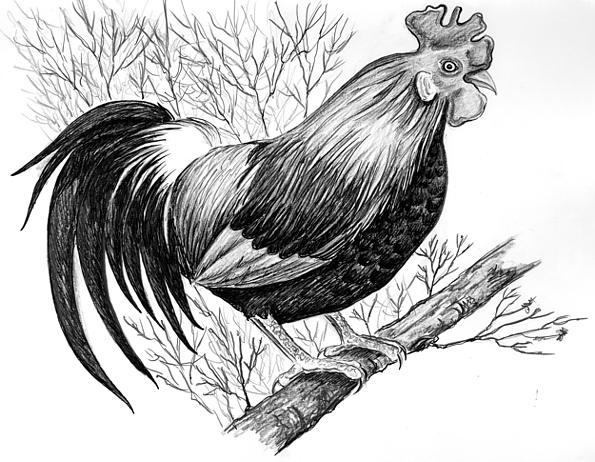
Dear Bird Folks,
My husband just gave me a copy of your book and believe it or not, I’m actually reading it. And because I’m reading it my bird IQ is soaring. However, there is one question you didn’t answer: Why aren’t chickens pictured in the bird guides? I understand they are domesticated birds, but domesticated ducks, geese and turkeys are often in the books. Why not chickens?
– Carol, Bellingham, WA
You are one lucky lady, Carol,
I don’t believe I’ve met your husband but I can tell right away he is a smart man. Out of all the millions of books out there, he choose my book to give to you. That clearly shows he is a good husband and a brilliant gift giver. Either that or my book was in the sale rack and he’s one of those cheap guys who can’t pass up a bargain. Whatever the reason, it’s all good because you got a free book, your bird IQ is soaring and I am able to shamelessly plug my book. What could be better?
The reason why domesticated chickens aren’t in our bird books is because wild chickens aren’t native to either North or South America. Conversely, we have both wild and domesticated geese, ducks and turkeys walking around this continent. Having pictures of those birds in the books makes sense. You would be surprised by how many people bring me pictures of a “mystery” duck or goose. They are convinced they have found some rare bird. They don’t believe me when I tell them that their rare bird has escaped from a pen someplace. It’s helpful when I’m able to point to a picture of their bird in a book. Domestic chickens, on the other hand, have no wild American counterparts to be confused with. If it looks like a chicken, it’s a chicken. Any birder who needs a book to identify a chicken may want to think about an easier hobby.
Some folks might argue that North America does indeed have native wild chickens. We have Lesser and Greater Prairie Chickens living in the plain states. Aren’t they chickens? Nope, they aren’t. They are actually grouse. Prairie chickens are chickens in name only. Just like cowbirds aren’t bovines and catbirds aren’t stupid cats.
In order to find truly wild chickens you will have to travel to the forests of southern-Asia. There you’ll find chickens that are as wild as any owl, heron or Blue Jay. If you look in a book on the birds of India or Thailand, you will see pictures of chickens alongside all the other native birds. However, you won’t see the name “chicken” printed under the bird’s image. Wild chickens are actually “junglefowl.” The Red Junglefowl (along with possibly the Gray Junglefowl) is thought to be the source of all of the world’s domestic chickens. Junglefowl look very much like those dopey domesticated chickens we see scratching around a farm, except these wild birds are wary of humans and try to avoid us. The domesticated birds are easy to tell from the wild ones because they are typically very tame and often have those weird pop-up timers sticking of out them.
Out of the roughly 10,000 bird species found throughout the world only about a dozen have ever been domesticated by humans. Researchers aren’t exactly sure when man was first able to domesticate the junglefowl, but it is thought to have happened around 5,000-9,000 B.C. Domesticated junglefowl provided early man with meat and eggs for food, plus feathers for primitive pillows and ornamentation. Records indicate that the first person to popularize chickens for food was Asia’s great Emperor Sanders. Very few Westerners have heard of Emperor Sanders because he was a modest man who didn’t like the title of Emperor. Instead, he insisted that his subjects call him “Colonel.”
At this point in the column I should tell you why the wild birds are referred to as junglefowl while the domesticated birds are called chickens. Wouldn’t it be great to know where the name “chicken” came from? The problem is I don’t know the answer to that question. You’ll have to ask Emperor Sanders. However, I do know that wild chickens aren’t the sissy birds that the name “chicken” might indicate. The males are extremely aggressive and protective of the females. They will often fight to the death in their defense. In many Third World countries the locals have taken note of the birds’ aggressive behavior and have organized recreational cockfights. Cockfighting is illegal in the United States because here it is considered to be cruel and inhumane. Instead we force the birds into cramped cages until they become so fat they can hardly walk. Then we hang them upside-down, cut off their heads and serve them in a paper bucket. Our chickens are so lucky they don’t live in those barbaric Third World countries.
I’m glad you asked about chickens, Carol. No bird has benefited humans more than they have, and yet most of us give them very little respect. The domesticated offspring of the lowly Red Junglefowl has proven to be a very successful species. On any given day there may be as many as 24,000,000,000 (that’s right, twenty-four billion) chickens living on the earth. Wait! Better change that number to 23,999.999,999. My carnivorous wife just walked in carrying a paper bucket.